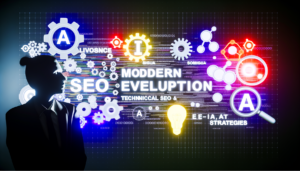The Role of Artificial Intelligence in Modern SEO Strategies
Search Engine Optimization (SEO) has evolved dramatically over the past decade, and artificial intelligence (AI) now sits at the heart of this transformation. As search engines like Google increasingly rely on machine learning algorithms to rank content, marketers must adapt their strategies to align with these technological advancements. This article explores how AI is reshaping SEO, from keyword research to content optimization and beyond. We’ll delve into practical applications, emerging tools, and the ethical considerations of relying on AI-driven solutions. Whether you’re a seasoned SEO professional or a business owner looking to improve online visibility, understanding the intersection of AI and SEO is no longer optional—it’s essential for staying competitive in a rapidly changing digital landscape.
AI-Powered Keyword Research and Intent Analysis
Traditional keyword research tools are being outpaced by AI systems capable of analyzing user intent with unprecedented accuracy. Platforms like Google’s BERT and third-party tools now process natural language queries to identify semantic relationships between words. This allows marketers to:
- Uncover long-tail keywords that align with specific search intent
- Predict shifts in user behavior based on real-time data trends
- Group keywords thematically to build topic clusters
By leveraging AI, businesses can move beyond static keyword lists and create content that answers nuanced questions, ultimately improving rankings and user engagement.
Content Optimization Through Machine Learning
AI-driven tools like Clearscope and MarketMuse analyze top-performing content to generate optimization recommendations. These platforms evaluate factors such as:
- Semantic relevance and contextual depth
- Readability scores adjusted for target audiences
- Competitor gap analysis for untapped opportunities
More advanced systems even draft content outlines or suggest structural improvements. However, over-reliance on AI-generated content risks homogenization—brands must balance automation with human creativity to maintain authenticity.
Technical SEO Automation and Predictive Analytics
AI excels at identifying technical issues that impact rankings, such as crawl errors, site speed bottlenecks, or mobile compatibility flaws. Tools like Botify use machine learning to:
- Prioritize fixes based on potential ranking impact
- Simulate how algorithm updates might affect traffic
- Automate repetitive tasks like metadata generation
Predictive analytics take this further by forecasting traffic trends or estimating the ROI of SEO investments, enabling proactive rather than reactive strategies.
Ethical Implications and Future Challenges
While AI offers efficiency, it raises questions about data privacy, algorithmic bias, and the potential for manipulation. Search engines are already combating AI-generated spam, and marketers must avoid tactics that prioritize machines over human audiences. The future of SEO will likely involve:
- Tighter integration between AI tools and ethical guidelines
- Increased emphasis on E-E-A-T (Experience, Expertise, Authoritativeness, Trustworthiness)
- Ongoing adaptation to AI-powered search interfaces like voice assistants
Striking the right balance between automation and human oversight will define successful SEO strategies in the AI era.
Conclusion
Artificial intelligence has irrevocably changed SEO, offering powerful tools for keyword research, content optimization, technical audits, and predictive analysis. However, these advancements come with responsibilities—marketers must avoid over-automation, prioritize ethical practices, and ensure content remains user-centric. As search algorithms grow smarter, the key to long-term success lies in combining AI’s analytical prowess with human creativity and strategic thinking. By staying informed about emerging technologies while maintaining a focus on genuine value, businesses can harness AI to build sustainable SEO strategies that adapt to both search engine requirements and evolving user expectations.


